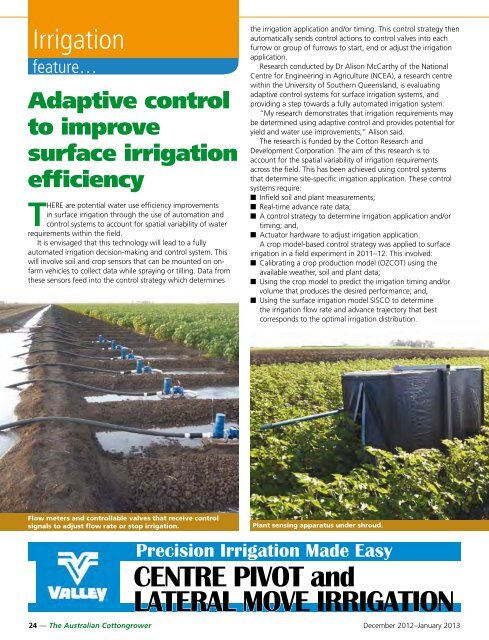cotton - Greenmount Press
cotton - Greenmount Press
cotton - Greenmount Press
You also want an ePaper? Increase the reach of your titles
YUMPU automatically turns print PDFs into web optimized ePapers that Google loves.
Irrigation<br />
feature…<br />
Adaptive control<br />
to improve<br />
surface irrigation<br />
efficiency<br />
THERE are potential water use efficiency improvements<br />
in surface irrigation through the use of automation and<br />
control systems to account for spatial variability of water<br />
requirements within the field.<br />
It is envisaged that this technology will lead to a fully<br />
automated irrigation decision-making and control system. This<br />
will involve soil and crop sensors that can be mounted on onfarm<br />
vehicles to collect data while spraying or tilling. Data from<br />
these sensors feed into the control strategy which determines<br />
the irrigation application and/or timing. This control strategy then<br />
automatically sends control actions to control valves into each<br />
furrow or group of furrows to start, end or adjust the irrigation<br />
application.<br />
Research conducted by Dr Alison McCarthy of the National<br />
Centre for Engineering in Agriculture (NCEA), a research centre<br />
within the University of Southern Queensland, is evaluating<br />
adaptive control systems for surface irrigation systems, and<br />
providing a step towards a fully automated irrigation system.<br />
“My research demonstrates that irrigation requirements may<br />
be determined using adaptive control and provides potential for<br />
yield and water use improvements,” Alison said.<br />
The research is funded by the Cotton Research and<br />
Development Corporation. The aim of this research is to<br />
account for the spatial variability of irrigation requirements<br />
across the field. This has been achieved using control systems<br />
that determine site-specific irrigation application. These control<br />
systems require:<br />
■ Infield soil and plant measurements;<br />
■ Real-time advance rate data;<br />
■ A control strategy to determine irrigation application and/or<br />
timing; and,<br />
■ Actuator hardware to adjust irrigation application.<br />
A crop model-based control strategy was applied to surface<br />
irrigation in a field experiment in 2011–12. This involved:<br />
■ Calibrating a crop production model (OzCOT) using the<br />
available weather, soil and plant data;<br />
■ Using the crop model to predict the irrigation timing and/or<br />
volume that produces the desired performance; and,<br />
■ Using the surface irrigation model SISCO to determine<br />
the irrigation flow rate and advance trajectory that best<br />
corresponds to the optimal irrigation distribution.<br />
Flow meters and controllable valves that receive control<br />
signals to adjust flow rate or stop irrigation.<br />
Plant sensing apparatus under shroud.<br />
Precision Irrigation Made Easy<br />
CENTRE PIVOT and<br />
LATERAL MOVE IRRIGATION<br />
24 — The Australian Cottongrower December 2012–January 2013

















